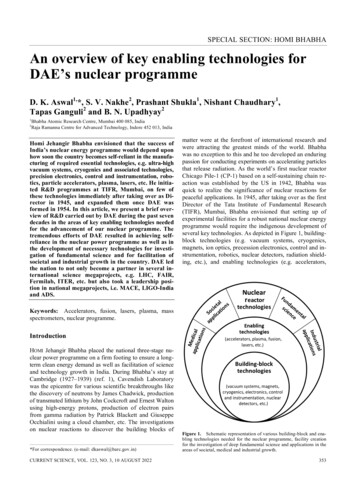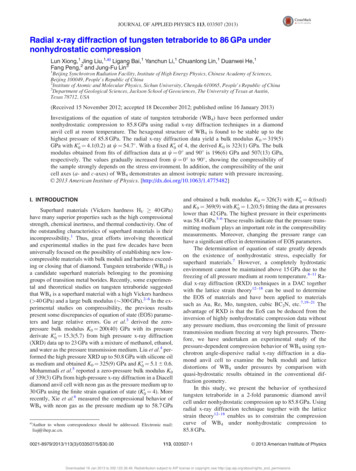
Transcription
JOURNAL OF APPLIED PHYSICS 113, 033507 (2013)Radial x-ray diffraction of tungsten tetraboride to 86 GPa undernonhydrostatic compressionLun Xiong,1 Jing Liu,1,a) Ligang Bai,1 Yanchun Li,1 Chuanlong Lin,1 Duanwei He,1Fang Peng,2 and Jung-Fu Lin31Beijing Synchrotron Radiation Facility, Institute of High Energy Physics, Chinese Academy of Sciences,Beijing 100049, People’s Republic of China2Institute of Atomic and Molecular Physics, Sichun University, Chengdu 610065, People’s Republic of China3Department of Geological Sciences, Jackson School of Geosciences, The University of Texas at Austin,Texas 78712, USA(Received 15 November 2012; accepted 18 December 2012; published online 16 January 2013)Investigations of the equation of state of tungsten tetraboride (WB4) have been performed undernonhydrostatic compression to 85.8 GPa using radial x-ray diffraction techniques in a diamondanvil cell at room temperature. The hexagonal structure of WB4 is found to be stable up to thehighest pressure of 85.8 GPa. The radial x-ray diffraction data yield a bulk modulus K0 ¼ 319(5)GPa with K00 ¼ 4.1(0.2) at w ¼ 54.7 . With a fixed K00 of 4, the derived K0 is 323(1) GPa. The bulkmodulus obtained from fits of diffraction data at w ¼ 0 and 90 is 196(6) GPa and 507(13) GPa,respectively. The values gradually increased from w ¼ 0 to 90 , showing the compressibility ofthe sample strongly depends on the stress environment. In addition, the compressibility of the unitcell axes (a- and c-axes) of WB4 demonstrates an almost isotropic nature with pressure increasing.C 2013 American Institute of Physics. [http://dx.doi.org/10.1063/1.4775482]VI. INTRODUCTIONSuperhard materials (Vickers hardness HV 40 GPa)have many superior properties such as the high compressionalstrength, chemical inertness, and thermal conductivity. One ofthe outstanding characteristics of superhard materials is theirincompressibility.1 Thus, great efforts involving theoreticaland experimental studies in the past few decades have beenuniversally focused on the possibility of establishing new lowcompressible materials with bulk moduli and hardness exceeding or closing that of diamond. Tungsten tetraboride (WB4) isa candidate superhard materials belonging to the promisinggroups of transition metal borides. Recently, some experimental and theoretical studies on tungsten tetraboride suggestedthat WB4 is a superhard material with a high Vickers hardness( 40 GPa) and a large bulk modulus ( 300 GPa).2–6 In the experimental studies on compressibility, the previous resultspresent some discrepancies of equation of state (EOS) parameters and large relative errors. Gu et al.3 derived the zeropressure bulk modulus K0 ¼ 200(40) GPa with its pressurederivate K00 ¼ 15.3(5.7) from high pressure x-ray diffraction(XRD) data up to 23 GPa with a mixture of methanol, ethanol,and water as the pressure transmission medium. Liu et al.4 performed the high pressure XRD up to 50.8 GPa with silicone oilas medium and obtained K0 ¼ 325(9) GPa and K00 ¼ 5.1 6 0.6.Mohammadi et al.5 reported a zero-pressure bulk modulus K0of 339(3) GPa from high-pressure x-ray diffraction in a Diacelldiamond anvil cell with neon gas as the pressure medium up to30 GPa using the finite strain equation of state (K00 ¼ 4). Morerecently, Xie et al.6 measured the compressional behavior ofWB4 with neon gas as the pressure medium up to 58.7 GPaa)Author to whom correspondence should be addressed. Electronic 5/ 30.00and obtained a bulk modulus K0 ¼ 326(3) with K00 ¼ 4(fixed)and K0 ¼ 369(9) with K00 ¼ 1.2(0.5) fitting the data at pressureslower than 42 GPa. The highest pressure in their experimentswas 58.4 GPa.3–6 These results indicate that the pressure transmitting medium plays an important role in the compressibilitymeasurements. Moreover, changing the pressure range canhave a significant effect in determination of EOS parameters.The determination of equation of state greatly dependson the existence of nonhydrostatic stress, especially forsuperhard materials.7 However, a completely hydrostaticenvironment cannot be maintained above 15 GPa due to thefreezing of all pressure medium at room temperature.8–11 Radial x-ray diffraction (RXD) techniques in a DAC togetherwith the lattice strain theory12–18 can be used to determinethe EOS of materials and have been applied to materialssuch as Au, Re, Mo, tungsten, cubic BC2N, etc.7,19–21 Theadvantage of RXD is that the EoS can be deduced from theinversion of highly nonhydrostatic compression data withoutany pressure medium, thus overcoming the limit of pressuretransmission medium freezing at very high pressures. Therefore, we have undertaken an experimental study of thepressure-dependent compression behavior of WB4 using synchrotron angle-dispersive radial x-ray diffraction in a diamond anvil cell to examine the bulk moduli and latticedistortions of WB4 under pressures by comparison withquasi-hydrostatic results obtained in the conventional diffraction geometry.In this study, we present the behavior of synthesizedtungsten tetraboride in a 2-fold paranomic diamond anvilcell under nonhydrostatic compression up to 85.8 GPa. Usingradial x-ray diffraction technique together with the latticestrain theory12–18 enables us to constrain the compressioncurve of WB4 under nonhydrostatic compression to85.8 GPa.113, 033507-1C 2013 American Institute of PhysicsVDownloaded 16 Jan 2013 to 202.122.36.46. Redistribution subject to AIP license or copyright; see http://jap.aip.org/about/rights and permissions
033507-2Xiong et al.J. Appl. Phys. 113, 033507 (2013)II. EXPERIMENTIII. THEORYSingle-phase WB4 was synthesized by the hot-pressedmethod starting with a mixture of W and B, and the synthesized WB4 has a hexagonal structure (space group P63/mmc) with lattice parameters a ¼ 5.199(0.001) Å andc ¼ 6.347(0.001) Å according to powder x-ray diffraction atambient conditions. A 2-fold paranomic DAC with a pair ofbeveled diamond anvils (150 lm culet) was used in theRXD measurements. A beryllium gasket was preindented to 25 lm thickness and drilled a hole of 50 lm diameter inthe center of preindentation as sample chamber. WB4 powder was loaded into the gasket hole and a Mo flake with diameter of 20 lm was placed on top of the sample servingas a pressure standard23 as well as the sample position reference. No pressure-transmitting medium was used to ensuremaximum nonhydrostatic stresses. The angle-dispersive radial x-ray diffraction experiments were performed on 4W2beamline at the Beijing Synchrotron Radiation Facility(BSRF), Chinese Academy of Sciences. A Si(111) monochromator was used to tune the synchrotron source with awavelength of 0.6199 Å, and the incident monochromaticx-ray beam was focused to a 26 8 lm2 full width at halfmaximum (FWHM) spot by a pair of Kirkpatrick-Baezmirrors. Two-dimensional diffraction patterns were collected by a Mar345 image plate detector and analyzed withthe program Fit2D.24 The distance and orientation of the detector were calibrated using a CeO2 standard. At eachincreasing pressure, the RXD pattern was collected afterabout 30 min to allow for stress relaxation.In a normal angle-dispersive radial x-ray diffractionexperiment, the incident x-ray is perpendicular to the compression axis and passes through a Be gasket. In order tominimize the contribution of Be diffraction lines to the sample patterns, the DAC was tilted to a a angle of 28 (seeFig. 1).14 In this geometry, the w corresponding to the anglebetween the diffracting plane normal and the loading axiswas calculated using the equation22According to the lattice strain theory,12–18 the stressstate at the center of the compressed polycrystalline sampleunder uniaxial loading in a diamond anvil cell is characterized by r1 and r3 , which is the maximum stress along theDAC loading axis and the minimum stress in the radial direction, respectively. rP is the mean normal stress and is equalto (2 r3 þ r1 )/3. The difference between r3 and r1 is themacroscopic differential stress, t (t ¼ r3 r1 ).The measured d-spacing dm(hkl) is a function of the azimuthal angle w between the diamond cell loading axis andthe diffraction plane normal and diffraction plane (hkl)cos whkl ¼ sin a cos d cos hhkl þ cos a sin hhkl ;(1)where h is the diffraction angle and d is the azimuthal anglein the plane of the detector.FIG. 1. Radial x-ray diffraction geometry used with a diamond anvil cell.The DAC was tilted to an a angle of 28 .dm ðhklÞ ¼ dp ðhklÞ½1 þ ð1 3 cos2 wÞQðhklÞ ;(2)where dm(hkl) is the measured d spacing, dp(hkl) is the dspacing due to the hydrostatic component of stress, andQðhklÞ is the orientation dependent lattice strain.14–17Eq. (2) suggests that dm(hkl) should vary linearly with1 3 cos2w, reaching a maximum at w ¼ 90 and minimum atw ¼ 0 , respectively. At w ¼ 54.7 (1–3 cos2w ¼ 0), the position of the observed x-ray diffraction lines reflects the dspacing due to the mean component of stress, so the equivalent hydrostatic compression curve can be directly derivedfrom the diffraction data at w ¼ 54.7 . The slope of thedm(hkl) versus 1 3 cos2w relation yields the product dp(hkl)QðhklÞ and dp(hkl) can be directly measured at w ¼ 54.7 .IV. RESULTS AND DISCUSSIONThe RXD diffraction patterns are integrated over eachazimuthal sectors with 5 internal using Fit2D24 for dataanalyses. The program Multifit 4.2 is used to perform macrodecomposition of 2D diffraction images into azimuthal slicesusing Fit2D24 to yield one-dimensional plots of x-ray intensity as a function of two-theta and fits peak positions, intensities, and FWHM of the diffraction peaks. To determine thevariation of the diffraction peaks’ positions with d, we usedthis software package to integrate the diffraction patternsand fit peak positions with segments of 5 intervals in theazimuth angle, in steps from 180 to 270 . Radial x-ray diffraction spectra of WB4 were collected up to an equivalentpressure of 85.8 GPa, where pressures were derived from theequation of state of Mo23 using the unit cell volume obtainedfrom the dp(110) of Mo at w ¼ 54.7 .Fig. 2 shows the selected diffraction patterns of the sample taken at whkl ¼ 54.7 under different pressures. Diffraction peak positions were fitted with Pseudo-Voigt line shapesusing the software package Multifit 4.2. Though seven diffraction peaks of WB4 (101, 002, 110, 201, 112, 103, 211)were observed in most diffraction patterns, the (002, 201,103, 211) peaks were relatively weaker, whereas the (110)peak begins to split at 45.0 GPa. One of the possible reasonsfor the splitting of WB4 (110) diffraction line is that the grainsize of WB4 is not homogeneous (0.5 lm–1.5 lm) and somebigger grains in a nonhydrostatic stress result in the discontinuity of pressure then the split of peak. The bigger grainsnear the edge of the sample chamber likely suffered lowerpressure as to generate the peak with lower 2h angle, asDownloaded 16 Jan 2013 to 202.122.36.46. Redistribution subject to AIP license or copyright; see http://jap.aip.org/about/rights and permissions
033507-3Xiong et al.FIG. 2. Selected diffraction patterns of WB4 under nonhydrostatic compression taken at w ¼ 54.7 . The pressures are determined from the Mo(110) atw ¼ 54.7 . The estimated errors are obtained from the scatter of d(hkl) versus 1 3 cos2w.J. Appl. Phys. 113, 033507 (2013)shown in Fig. 2. Another reason for the peak splitting maybe that the strong shear stress under uniaxial compressioncauses to a change in the crystal structure. But this needs further examination.The dm (hkl) variation with 1 3 cos2w for WB4 (101),(110), (112), and (201) diffraction lines at six selected pressures is shown in Fig. 3. The d-spacing of the WB4 (110)diffraction line is obtained from a stronger peak positionafter 45.0 GPa. As expected from the theory, the measuredd-spacings vary linearly with 1 3 cos2w.The d-spacings of dp(101), dp(201), dp(112) and dp(211),corresponding to hydrostatic components of stress, werederived from the intercept of the dm(hkl) versus 1-3cos2w relation at (1-3cos2w)¼0 (w¼54.7 ) and used to calculate the lattice parameters fitting to a hexagonal cell. The normalizedunit cell volume of compression curves for w ¼ 0 , w ¼ 54.7 ,and w ¼ 90 are shown in Fig. 4. For comparison, the resultsobtained in earlier normal XRD under quasi-hydrostatic compression were also included.3,4,6 Angles w ¼ 0 and 90 represent the diffracting plane normal being parallel andperpendicular to the load axis respectively, and the stress environment of the sample is maximum and minimum respectively. It is evident from Fig. 4 that our experimental datahave very good fitting precision.FIG. 3. Dependence of observed d-spacing on 1 3 cos2w for the WB4 (101), (110), (112), and (201) diffraction lines at different pressures. The solid lines areleast-squares fits to the data.Downloaded 16 Jan 2013 to 202.122.36.46. Redistribution subject to AIP license or copyright; see http://jap.aip.org/about/rights and permissions
033507-4Xiong et al.J. Appl. Phys. 113, 033507 (2013)TABLE I. A summary of the bulk modulus (K0) of WB4 and their pressurederivative (K00 ) obtained from various methods. Asterisk indicates methanolethanol mixture in the volume ratio of 4:1. GGA refers to the generalizedgradient gradient approximation; LDA refers to local density approximation;PTM refers to pressure-transmitting medium.FIG. 4. Compression curves of WB4 from lattice parameters measured at 0 ,54.7 , and 90 . The solid lines are Birch-Murnaghan equation fitting lines tothe data at each angle. Other reported compression data of WB4 are alsoshown for comparison. The open circles are the static compression data ofRef. 3. The open squares are the static compression data obtained by Liu et al.of Ref. 4. The open diamonds are the static compression data of Ref. 6.The unit cell volumes as a function of pressure were fitted using third-order Birch–Murnaghan EOS to obtain theambient pressure bulk modulus K0 and its pressure derivateK00 . The third-order Birch–Murnaghan EOS is expressed asfollows:25" 7 5 #(" 2#)V0 3V0 33 0V0 31 þ ðK0 4ÞP ¼ 1:5 K0 1 ;VVV4(3)where K0, K00 , and V0 are the bulk modulus, its pressure derivate, and the unit-cell volume at ambient conditions, respectively. Through fitting the diffraction data at w ¼ 54.7 up to86 GPa by Eq. (3), we obtain the bulk module K0 ¼ 319(5)GPa and its pressure derivative K00 ¼ 4.1(0.2).With a fixed K00 of 4, the least-squares fit yields an ambient bulk modulus the derived K0 ¼ 323(1) GPa. The bulkmodulus obtained from fits of diffraction data at w ¼ 0 and90 is 196(6) GPa and 507(13) GPa, respectively. Anglesw ¼ 0 and 90 represent the diffracting plane normal beingparallel and perpendicular to the load axis respectively, andthe stress environment of the sample is maximum and minimum, respectively.A comparison between our research results and the previously reported data2–6 on the bulk modulus (K0) and itspressure derivative (K00 ) is shown in Table I. It can be seenthat, the comparison of the bulk modulus derived from different w suggests a variation of a factor of 2.6 betweenw ¼ 0 and w ¼ 90 . The values gradually increased fromw ¼ 0 to w ¼ 90 , showing the compressibility of the samplestrongly depends on the stress environment. In addition, thebulk modulus of WB4 obtained here under uniaxial compression at w ¼ 54.7 is in roughly consistent with that from xray diffraction under quasi-hydrostatic condition obtainedfrom Xie et al. within the experimental error as well as inaccord with the value obtained by theoretical calculationK0 (GPa)K00Pmax (GPa)Method and xed)4(fixed)4(fixed)1.2(0.5)85.8This work23RXD (w ¼ 54.7 ), nullRXD (w ¼ 54.7 ), nullRXD (w ¼ 0 ), nullRXD (w ¼ 90 ), nullXRD, alcohol*50.8XRD, silicone oilLiu et al.43042XRD, neon gasXRD, neon gasMohammadi et al.5Xie et al.6Theory (GGA)Theory (LDA)Wang et al.2Gu et al.3local density approximation (LDA),2–6 while it is much bigger than 200(40) GPa obtained by Gu et al.3 The pressure derivative obtained from third-order Birch-Murnaghanequation of state is very close to 4 and the values of K0 are inhighly consistent, demonstrating that we obtained goodresults for hydrostatic condition. Due to the freezing of allknown pressure media at high pressures, a completely hydrostatic environment cannot be retained above 15 GPa.8–11This has an effect of overestimating the equation of state parameters. As a consequence, using radial x-ray diffractiontechniques in a pressure cell can have the profound advantages when investigating the equations of state of superhardmaterials such as WB4 at very high pressures.The pressure dependence of the normalized lattice parameters of the hexagonal phase compared with the resultsreported previously.3,4,6 is shown in Fig. 5. The fitting resultof entire pressure range yieldsFIG. 5. Compressibility of the normalized lattice parameters of WB4 compared with the data obtained by Gu et al. (Ref. 3), Liu et al. (Ref. 4), andXie et al. (Ref. 6).Downloaded 16 Jan 2013 to 202.122.36.46. Redistribution subject to AIP license or copyright; see http://jap.aip.org/about/rights and permissions
033507-5Xiong et al. 2aPP¼ 1 9:2 10 4þ 3:0 10 6a0P0P0J. Appl. Phys. 113, 033507 (2013)(4)compressibility of the unit cell axes (a- and c-axes) of WB4demonstrates an almost isotropic nature and a good regularity with pressure increasing.and 2cPPþ 3:0 10 6¼ 1 9:8 10 4:c0P0P0ACKNOWLEDGMENTS(5)The relative change along the a-axis is about 5.5% and thatalong the c-axis is about 6.1% from 1.4 GPa to 85.8 GPa.The axial compression is almost isotropic as both axes havea similar compressibility, which is in good agreement withGu et al. and Xie et al.’s conclusion.3,6 The reason for its isotropic nature of compressibility different from usual hexagonal structure materials is that the unique covalent bondingnetwork, with B-B covalent bonds aligned along the c-axisresults in a quasi-isotropic compressibility.3,6The compression behavior of the a- and c-axes shows agood regularity in the entire pressure range investigated incontrast to that derived from the measurments by Liu et al.and Xie et al.4,6 At higher pressures, after about 25 GPareported by Liu et al.,4 the compression behavior of the aand c-axes is likely to be abnormal. The authors interpretedthe freezing of silicone oil at high pressures and the increasing of the uniaxial stress component.8,10,11 Xie et al. reportedthat the c axis suddenly undergoes a softening and becomessignificantly more compressible than the a-axis at 42 GPa,while, a-axis does not show any change in behavior. Due tothe WB4 diffraction patterns remaining the same, with no observation of peak broadening or splitting at the point of thestructural change at 42 GPa, and the c-lattice constant recovering its original strain values upon decompression, theyassigned that anomaly to a structurally induced reversiblesecond-order phase transition because of the threedimensional, almost isotropic, rigid covalently boron network.6 The c-axes uncompressibility obtained from Xieet al. is a little higher than the a-axes uncompressibility,whereas our research results and the results obtained fromLiu et al. show an oppose conclusion.4,6 The differences maybe due to different synthesize methods, grain sizes of different starting materials, and/or hydrostaticity.V. CONCLUSIONUsing radial x-ray diffraction technique together withthe lattice strain theory, we examined the behavior of WB4in a diamond anvil cell under nonhydrostatic compression upto 85.8 GPa. The bulk modulus of WB4 derived from thenonhydrostatic compression data can vary nearly a factor of2.6 depending on the relative orientation of the diffractionnormal and diamond cell stress axis. The compression curveobtained at w ¼ 54.7 yields a bulk modulus K0 ¼ 319(5)GPa and its pressure derivative K00 ¼ 4.1(0.2). The bulk modulus under w ¼ 54.7 is close to previous experimentalresults under quasi-hydrostatic conditions derived from Xieet al. and the theoretically predicted value. In addition, theThe authors thank Xiaodong Li and Haini Dong fortechnical assistance and helpful discussion. Financial supports from the National Natural Science Foundation of China(Nos.10875142 and 11079040, 11027405, and 10976018)and the National Basic Research Program of China (No.2011CB808200) are gratefully acknowledged. This workwas performed at 4W2 beamline of Beijing SynchrotronRadiation Facility (BSRF), which is supported by ChineseAcademy of Sciences under Grant Nos. KJCX2-SWN03 andKJCX2-SW-N20. J.F.L acknowledges support from EnergyFrontier Research in Extreme Environments (EFree) and theCarnegie/DOE Alliance Center (CDAC).1C. M. Sung and M. Sung, Mater. Chem. Phys. 43, 1 (1996).M. Wang, Y. W. Li, T. Cui, Y. M. Ma, and G. T. Zou, Appl. Phys. Lett.93, 101905 (2008).3Q. F. Gu, G. Krauss, and W. Steurer, Adv. Mater. 20, 3620 (2008).4C. J. Liu, F. Peng, N. Tan, J. Liu, F. J. Li, J. Q. Qin, J. H. Wang, Q. M.Wang, and D. W. He, High Press. Res. 31, 275 (2011).5R. Mohammadi, A. T. Lech, M. Xie, B. E. Weaver, M. T. Yeung,S. H. Tolbert, and R. B. Kaner, Proc. Natl. Acad. Sci. U.S.A. 108, 10958(2011).6M. Xie, R. Mohammadi, Z. Mao, M. M. Armentrout, A. Kavner, R. B.Kaner, and S. H. Tolbert, Phys. Rev. B 85, 064118 (2012).7D. W. He and T. S. Duffy, Phys. Rev. B 73, 134106 (2006).8I. Fujishiro, G. J. Piermarini, S. Block, and R. G. Munro, “High pressurein research and industry,” in Proceedings of the 8th AIRAPT ConferenceUppsala, edited by C. M. Backman, T. Johannisson, and L. Tegner (ISBN,Sweden, 1982), Vol. II, p. 608.9P. M. Bell and H. K. Mao, Annual Report, year book of the Carnegie Institution, (G. P. O., Washington, D. C., 1975), p. 399.10D. D. Ragan, D. R. Clarke, and D. Schiferl, Rev. Sci. Instrum. 67, 494(1996).11Y. R. Shen, R. S. Kumar, M. Pravica, and M. F. Nicol, Rev. Sci. Instrum.75, 4450 (2004).12A. K. Singh, J. Appl. Phys. 73, 4278 (1993).13A. K. Singh, C. Balasingh, H. K. Mao, R. J. Hemley, and J. F. Shu,J. Appl. Phys. 83, 7567 (1998).14A. K. Singh, J. Phys. Chem. Solids 65, 1589 (2004).15A. K. Singh and C. Balasingh, J. Appl. Phys. 75, 4956 (1994).16A. K. Singh, H. K. Mao, J. F. Shu, and R. J. Hemley, Phys. Rev. Lett. 80,2157 (1998).17A. K. Singh, J. Appl. Phys. 106, 043514 (2009).18A. K. Singh and H. P. Liermann, J. Appl. Phys. 109, 113539 (2011).19H. N. Dong, D. W. He, T. S. Duffy, and Y. S. Zhao, Phys. Rev. B 79,014105 (2009).20T. S. Duffy, G. Y. Shen, J. F. Shu, H. K. Mao, R. J. Hemley, and A. K.Singh, J. Appl. Phys. 86, 6729 (1999).21T. S. Duffy, G. Y. Shen, D. L. Heinz, J. F. Shu, Y. Z. Ma, H. K. Mao, R. J.Hemley, and A. K. Singh, Phys. Rev. B 60, 15063 (1999).22S. Merkel, H. R. Wenk, J. F. Shu, G. Y. Shen, P. Gillet, H. K. Mao, andR. J. Hemley, J. Geophys. Res. 107, 2271, doi:10.1029/2001JB000920(2002).23R. S. Hixson and J. N. Fritz, J. Appl. Phys. 71, 1721 (1992).24A. P. Hammersley, S. O. Svensson, M. Hanfland, A. N. Fitch, andD. H ausermann, High Press. Res. 14, 235 (1996).25F. Birch, J. Geophys. Res. 83, 1257, doi:10.1029/JB083iB03p01257(1978).2Downloaded 16 Jan 2013 to 202.122.36.46. Redistribution subject to AIP license or copyright; see http://jap.aip.org/about/rights and permissions
dial x-ray diffraction experiments were performed on 4W2 beamline at the Beijing Synchrotron Radiation Facility (BSRF), Chinese Academy of Sciences. A Si(111) mono-chromator was used to tune the synchrotron source with a wavelength of 0.6199A , and the incident monochromatic x-ray beam was focused to a 26 8lm2 full width at half
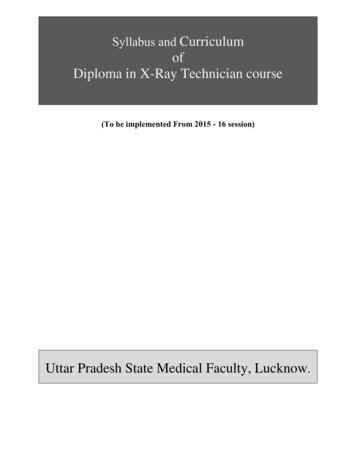

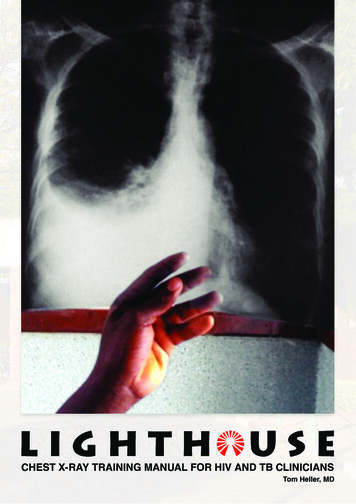
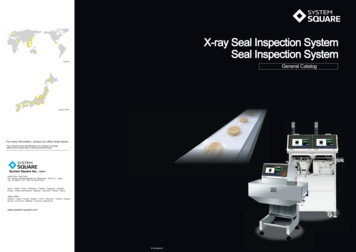
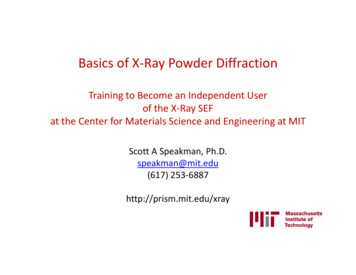
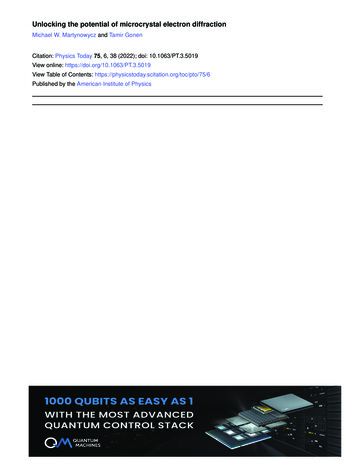
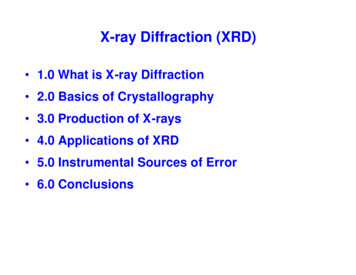
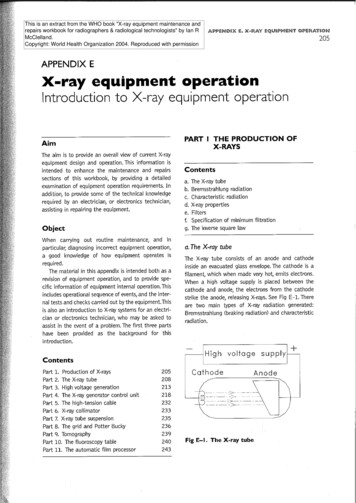
![[AWS Black Belt Online Seminar] AWS X-Ray](/img/17/20200526-blackbelt-x-ray.jpg)

